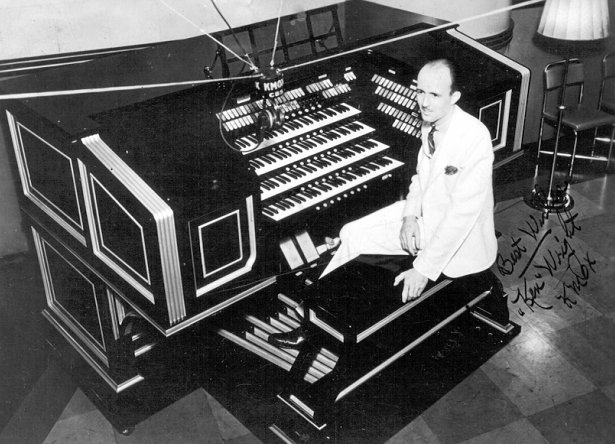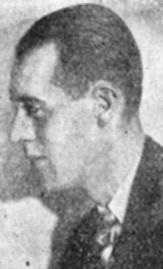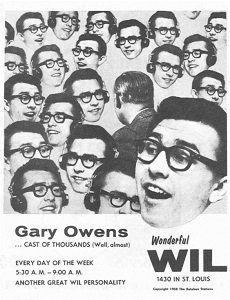 When he was a wee lad of three Ken Wright started playing original compositions – too original, some of them – on the piano. Then he graduated to a three-quarter violin to suit his childish chubbiness and thence to adept piano playing and finally to concert organ work.
When he was a wee lad of three Ken Wright started playing original compositions – too original, some of them – on the piano. Then he graduated to a three-quarter violin to suit his childish chubbiness and thence to adept piano playing and finally to concert organ work.
You see, he was designed for a musical career even some twenty-two years ago when he gladdened his mother’s heart by playing these delightful three-year-old bits on the piano. She was a music teacher and it was just in that field that she hoped he would finally land.
He hails from Great Bend, Kansas, a village of some 6,000 souls, and it was there that he received the greatest part of his education both musical and educational. When he was eighteen, he decided that he would rather play an organ than anything else and in less than a year he was the rage at church and was sought after to open theaters in various cities in the great state of Kansas.
After he had achieved all honors that could be accorded to one young man in his home state, he landed in Menominee, Michigan, in a theater, and was there and thereabouts for four years.
He was featured in theaters as a master of ceremonies where he led an orchestra and introduced acts and played the organ. In his spare time he learned to play the accordion since it was easier to carry about than a piano or organ. His first radio work was done while he was there when he played from a theater for remote broadcasts, and he is given credit for having originated the novelty type of program. You may have read an extensive article crediting him with this advance of theater and microphone technique in the September 1931 edition of the Motion Picture Herald.
Last September he decided to take radio more seriously and came down to St. Louis where he joined the staff of KMOX been heard on original programs of his own, in-studio features, and has adapted his original theater title of “The Singing Organist” in his daily morning programs where he sings an all-request hymn feature called “Morning Reveries.”
When he came here, he and Sunny Joe, the banjoist, formed a team, and by way of contrast, Walter Richards, the Program Production Director, dubbed him Sad Sam. So he is the same person, Sad Sam the accordionist, and Ken Wright the organist. Each program is typically different and indicative of the versatility of his ability and character.
Ken and Sad Sam, since he is the same, is probably the most serious minded person to be so merry that I have ever had the pleasure of knowing. His work is his paramount interest and one can practically feel his intent interest in his work when he is near. He has cabinets and more cabinets full of music through which he pours [sic] with all possible application when he is designing a single program for his listeners.
He is six-feet-two with brown hair and violet colored eyes. His features are regular and have the most flashing smile of great conviction. He is devoutly interested in every possible angle of his work and in his friends. One has the feeling that he is a trifle romantic but try as hard as I could, I could not discover what his ideal girl would be.
He has the forehead of a scholar and his eyes are rather quizzically slanted which might be an indication of the part that he is playing when he is Sad Sam. Ken speaks a good brand of French all of which he has mastered by himself and is thoroughly conversant on most of the intellectual subjects that there are.
He is likable and friendly and talented and handsome, in fact he answers the ideal requisite which one would create in one’s mind as his favorite radio entertainer. That he is a favorite is indicated by the several thousand fan letters he has received.
(Originally published in Radio and Entertainment 2/11/33).
 Holland Engle started his career as a child actor in 1910, when he played the juvenile lead in “The Little Wedding.” In 1912 when five years old, young Engle was playing a guitar before swinging doors for pennies, graduating finally into the inner “company rooms.”
Holland Engle started his career as a child actor in 1910, when he played the juvenile lead in “The Little Wedding.” In 1912 when five years old, young Engle was playing a guitar before swinging doors for pennies, graduating finally into the inner “company rooms.” When he was a wee lad of three Ken Wright started playing original compositions – too original, some of them – on the piano. Then he graduated to a three-quarter violin to suit his childish chubbiness and thence to adept piano playing and finally to concert organ work.
When he was a wee lad of three Ken Wright started playing original compositions – too original, some of them – on the piano. Then he graduated to a three-quarter violin to suit his childish chubbiness and thence to adept piano playing and finally to concert organ work. He may be strictly for the early birds, but Gary Owens takes his civic responsibilities seriously. On Station WIL from 5:30 to 9 each morning, he wakes up St. Louis. It takes some doing. Gary must first rouse himself, then his wife “Arty” (Arlette), then one-by-one the “cast of thousands” who assist him in his morning shenanigans. Despite the heavy labor, Gary insists he enjoys the routine – “especially around 4 ayem, when I make coffee in my pajamas.” (“Sometimes,” quips Gary, “I wish we had a percolator!”)…But the cast of thousands don’t wake easily. For the most part they’re a rascally bunch, destined to get coal in their stockings come Christmas. Among the leaders are Clinton Feemish, career nepotist; Fenwick Smoot, unlisted; The Marquis de Sade; and an amoeba named Frank. For a fictional break, Gary puts on his horn-rimmed glasses and plays “Uncle Don” reading the funnies. “Suddenly a huge black-lettering balloon comes out of the head of Rex Migraine, M.D.,” narrates the GO-man, “and in big, black letters spells, ‘Sorry, I can’t remove your pancreas for only $25; however I may be able to loosen it a bit’…The nurses in the series,” puns Gary, “are just too cute for wards.”…Back in Plankinton, South Dakota, some 24 years ago, Gary didn’t have such heavy duties. Just born, no matter how hard he cried, he couldn’t wake more than 750 sleepyheads – the entire Plankinton population. On the “GO” ever since, Gary’s been artist, journalist and deejay extraordinary. Gary also has the distinction of being the first American deejay to phone Moscow to ask if they kept a Top Forty list. “It was a Party Line,” Gary surmises. “They told me the U.S.S. R. prefers the classics.”…Because his wife Arty majored in psychology in college, she understands GO and shares all of his “real gone” enthusiasms – like sipping espresso and playing Monopoly. But then it’s time for WIL’s wake-up man to quiet down. By nature he’s not an insomniac, but, before drifting off, Gary likes to think about his great system for rabbit-hunting in St. Louis. “You just wait for the rabbit to come by,” says GO, “and make a noise like a carrot!”
He may be strictly for the early birds, but Gary Owens takes his civic responsibilities seriously. On Station WIL from 5:30 to 9 each morning, he wakes up St. Louis. It takes some doing. Gary must first rouse himself, then his wife “Arty” (Arlette), then one-by-one the “cast of thousands” who assist him in his morning shenanigans. Despite the heavy labor, Gary insists he enjoys the routine – “especially around 4 ayem, when I make coffee in my pajamas.” (“Sometimes,” quips Gary, “I wish we had a percolator!”)…But the cast of thousands don’t wake easily. For the most part they’re a rascally bunch, destined to get coal in their stockings come Christmas. Among the leaders are Clinton Feemish, career nepotist; Fenwick Smoot, unlisted; The Marquis de Sade; and an amoeba named Frank. For a fictional break, Gary puts on his horn-rimmed glasses and plays “Uncle Don” reading the funnies. “Suddenly a huge black-lettering balloon comes out of the head of Rex Migraine, M.D.,” narrates the GO-man, “and in big, black letters spells, ‘Sorry, I can’t remove your pancreas for only $25; however I may be able to loosen it a bit’…The nurses in the series,” puns Gary, “are just too cute for wards.”…Back in Plankinton, South Dakota, some 24 years ago, Gary didn’t have such heavy duties. Just born, no matter how hard he cried, he couldn’t wake more than 750 sleepyheads – the entire Plankinton population. On the “GO” ever since, Gary’s been artist, journalist and deejay extraordinary. Gary also has the distinction of being the first American deejay to phone Moscow to ask if they kept a Top Forty list. “It was a Party Line,” Gary surmises. “They told me the U.S.S. R. prefers the classics.”…Because his wife Arty majored in psychology in college, she understands GO and shares all of his “real gone” enthusiasms – like sipping espresso and playing Monopoly. But then it’s time for WIL’s wake-up man to quiet down. By nature he’s not an insomniac, but, before drifting off, Gary likes to think about his great system for rabbit-hunting in St. Louis. “You just wait for the rabbit to come by,” says GO, “and make a noise like a carrot!”